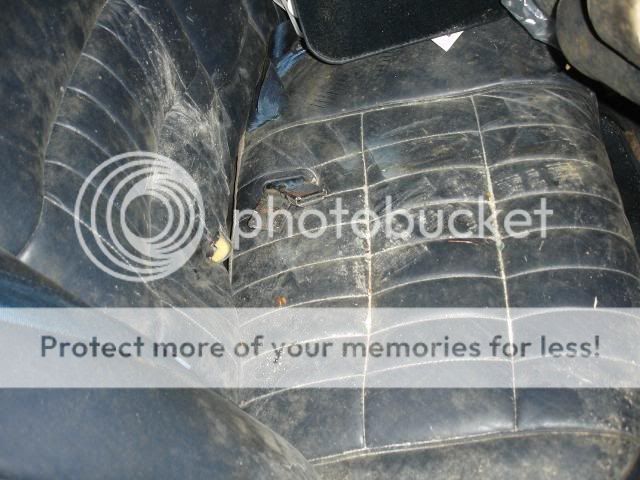It looks like you're using an Ad Blocker.
Please white-list or disable AboveTopSecret.com in your ad-blocking tool.
Thank you.
Some features of ATS will be disabled while you continue to use an ad-blocker.
share:
Question:
The pole on the ground with the cab is bent. The standing poles don't appear bent. I assume they were all straight to begin with.
How did that bent light pole get through the windshield?
Remember, this is just a hypothesis for the pole scenario, setting aside for the moment that the aircraft was actually proven on the north flight path and could not possibly have knocked down the light poles.

Approximate locations of where light poles allegedly ended up. Red dot is base location.

Yes they were straight originally, and I think it is safe to assume that the windshield did not bend the pole. The lamp head is 40 feet off the ground, and the straight main light pole looks to be about 37 feet long, is tapered from 10 inches at the bottom to 6 inches at the top, and is extruded from 1/8 inch thickness aluminum. The original pole weighs 247 pounds, with 20 pounds for the truss arm assembly and 70 pounds for the lamp head added, to give a total weight of 337 pounds for each light pole standing there, before the 180,000 pound (90 ton) aircraft allegedly hit them at 535 mph. (784.8 feet per second (fps))

The distance between #1 light pole and #5 light pole seems to be about 700 feet. At 784.8 fps the 124 ft 10 in aluminum wings of the alleged 757 would have been battered five times in less than one second by these 337 pound stationary objects. If you were to skid your car sideways into a 165 pound stationary human at 40 mph at the rear fender, would the steel fender be damaged? Of course it would. Would the damage be greater if that human weighed 337 pounds? Of course it would. What if your car hit the human 13 times (535 mph) as fast, would the damage be a good deal greater? Certainly.
So how could aircraft wings possibly survive this tremendous battering within one second, and possibly remain strong enough to survive the high G load to suddenly pull-up to level flight across the lawn from the steep descent down the hill. This alleged battering of the wings alone renders the light pole scenario IMPOSSIBLE, even without the addition of the Lloyde England script. Agreed?
Actual locations of light poles before removal

That piece of pole lying beyond the cab seems about three or four feet long and seems to be broken off the main pole. Logic would insist that the break was where a truss arm was attached via 4 drilled holes, rendering the main pole weaker there. Therefore the main pole remaining to be used as a missile would be about 33 feet long. However that main light pole has a big nicely radiused bend in it near the smaller end. In fact that bend looks so perfect, it must have been formed in a mechanical bending machine. Again, the windshield and dash could not have bent that heavy pole.

It seems that the 33 ft main light pole would necessarily need to be hurled at the windshield like a javelin (not rotating like a baton) in order to pierce the windshield, go between the front seats, and come to a stop with the smaller curved end in the back seat, and the heavier base end sticking out past the center of the hood in mid air about 22 feet. Even the hood ornament was untouched. Note that the curvature in the light pole would make the profile of the javelin much too large to fit the hole in the windshield. Also using common sense, one would expect gravity to rotate the curvature of the pole downward which would definitely not fit the hole. So how did that huge curved javelin get through the windshield without hitting the hood, hitting the roof, or hitting Lloyde? It is just not possible.
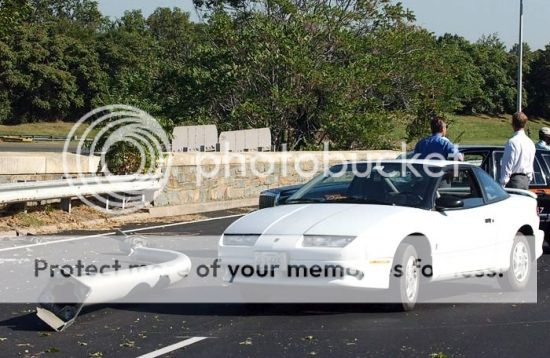
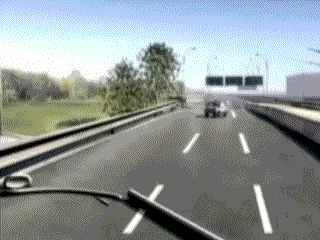
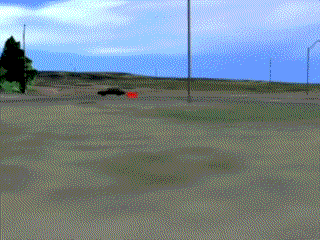
Lloyde was driving south on Hwy 27 at 40 mph and the light pole needed to be hurled under or over the aircraft fuselage by the right wing, and up the road 300 or 400 feet to meet the taxi windshield. That would be just past the beginning of that little taxi animation above. To hurl that light pole 350 to 450 feet would require tremendous force applied, and a tremendous initial velocity to the light pole. Of course this velocity to the #1 light pole was applied in the wrong direction, because the aircraft was headed east and the taxi was to the north. And the other four light poles reacted much differently; #2 flew a short ways (about 25 feet) sideways, and #3 4 5 just fell over a few feet from their bases. But #1 flew 400 feet past the fuselage? Strange light poles; you would agree?

So with all that velocity added to the light pole, the kinetic energy applied to the taxi would be great, and the kinetic energy added by the 3000 lb taxi at 40 mph would be great also. Let us assume the light pole had a speed of 40 mph when it reached the windshield. With a combined impact speed of 80 mph, how did the 200+ lb light pole come to a stop in 6 feet; stopped allegedly by a mere leather seat? This entire fairy tale is too ludicrous to comprehend. I cannot see how there is one single person in the entire world, including children, who would believe such silly nonsense.
Multiple blows to the windshield. I count 7. How about you?
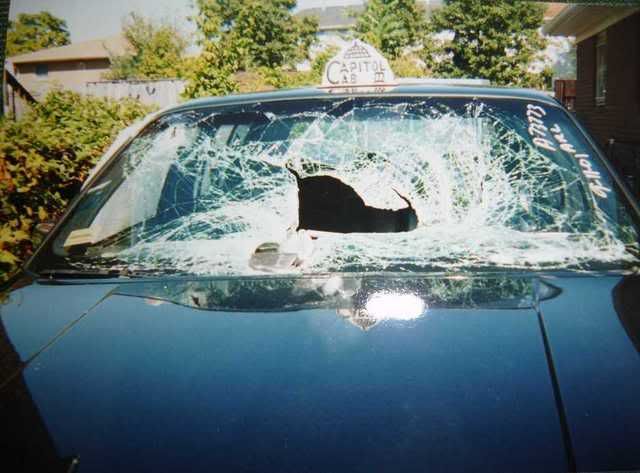
Alleged Light Pole Damage To Taxi - Possible? Impossible?
Nah. Not possible at all.
[edit on 10/31/08 by SPreston]

I believe at one point in the video (48:20), when Lloyde was standing near the front of the taxi, he seemed to indicate he was standing right at the bumper when he and the quiet mystery stranger pulled it out of the windshield. But he did not really finish what he started to say.
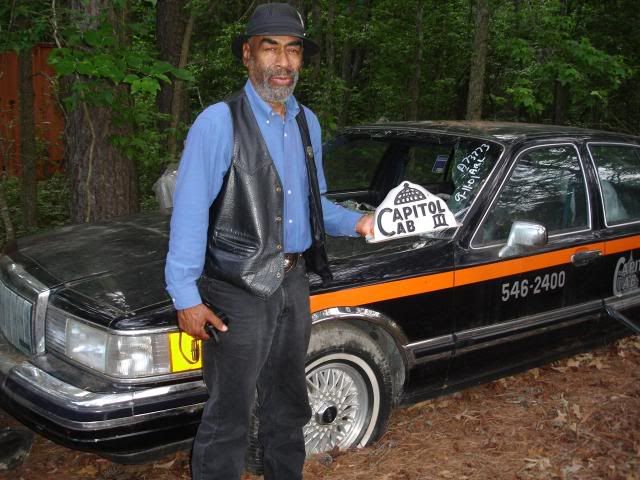
Well assuming that is where he was when he allegedly removed the pole, I have estimated the remaining length of the bent pole was 33 feet; 6 feet was inside the windshield, 5 feet over the hood, and the heaviest remaining base end sticking out 22 feet past the bumper in mid-air. There is no possibility it was resting on the ground. Also that 22 feet plus the 5 feet over the hood, was allegedly supported in mid-air by the dash and the short 6 feet stuck in the rear seat. That is ridiculous. Imagine the pole remaining precariously in that position, as the taxi braked to a stop sideways from 40 mph, and just try not to laugh out loud. I dare you. The heavy base end had to be at least 3 feet high above the ground for the pole to clear the unmarked hood. It would be possible to lift it out from there, just by stepping back and lifting as the lower bent portion caught on the dash and windshield; Lloyd at the bumper and the quiet mystery stranger at the base.
Google Video Link |
But Lloyde seemed to indicate in the first interview that the pole bend was sideways inside the taxi, and rolled down when it came out of the windshield, and knocked him down with the pole on top of him. If so, it should have damaged the hood, and it did not.
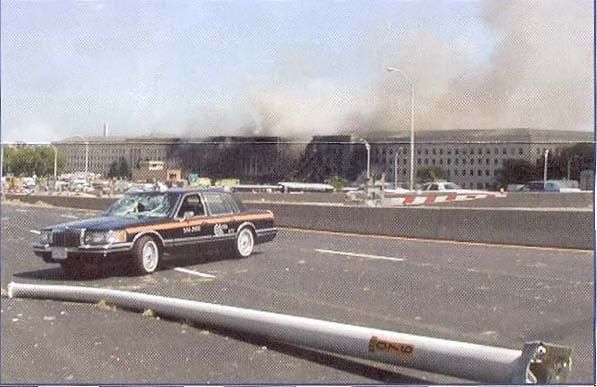
Actually looking at that professional bend in the pole again, the center of that bend would have been about 6 feet from the end in the back seat, and right at the windshield. Even supposing the seat could hold its end of the pole securely, the pole still would have rotated down to its center of gravity while still in the taxi. It is not possible that the hood ornament and hood would not have been damaged and scratched. Such a ridiculous script. Who wrote this nonsense? Dubya? Is that why you were hiding out in Florida behind small children? You were there on 9-10-2001. Did you do this?
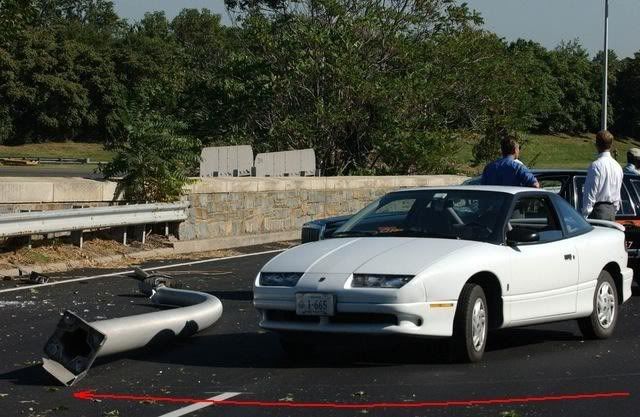
I believe its possible for the lightpole to hit without touch the hood because it flipped, kind of like holding the end of a pencil and hitting the
tip of it, causing it to flip instead of falling down like a tree that should hit both the hood and the windshield. My opinion.
Originally posted by deltaboy
I believe its possible for the lightpole to hit without touch the hood because it flipped, kind of like holding the end of a pencil and hitting the tip of it, causing it to flip instead of falling down like a tree that should hit both the hood and the windshield. My opinion.
Is this about how you picture the bent light pole inside Lloyde England's taxicab?

About 6 feet inside the windshield, between the front seats, and stuck into the back seat;
and about 27 feet hanging out over and past the hood in mid-air, never touching the hood even when the taxicab is skidding to a stop sideways from 40 mph?

[edit on 10/31/08 by SPreston]
Did any of the pictures show cuts or scratches to Lloydes face due to flying glass from the smashed windscreen at the alleged point of impact?
Why was the car not repaired?
There really isn't that much damage as far as we know, just cosmetic and the damaged dash and windshield?
Insurance would have covered it right?
So why not repair it, makes no sense, except wasn't he given a new car?
Could it have been as simple as, 'hey go with this story and you get a new car'? Maybe with a couple of threats thrown in? He did seem to know that the perpetrators were 'money men' with power. Maybe the guy in the white van that helped him wasn't as quiet as Lloyd claims? Did the man tell Lloyd what to say? Did the man tell Lloyd that he would have to deal with those 'men of power' if he disobeyed? Maybe they new about his interest in conspiracy and knew he would probably be easy to scare into silence?
There really isn't that much damage as far as we know, just cosmetic and the damaged dash and windshield?
Insurance would have covered it right?
So why not repair it, makes no sense, except wasn't he given a new car?
Could it have been as simple as, 'hey go with this story and you get a new car'? Maybe with a couple of threats thrown in? He did seem to know that the perpetrators were 'money men' with power. Maybe the guy in the white van that helped him wasn't as quiet as Lloyd claims? Did the man tell Lloyd what to say? Did the man tell Lloyd that he would have to deal with those 'men of power' if he disobeyed? Maybe they new about his interest in conspiracy and knew he would probably be easy to scare into silence?
Originally posted by tezzajw
Did any of the pictures show cuts or scratches to Lloydes face due to flying glass from the smashed windscreen at the alleged point of impact?
No. They pretty much kept Lloyde back away from the cameras for the photo ops. I don't recall one single close-up of Lloyde's face on 9-11. But on the images we did see, there were no sign of bandages or bandaids on Lloyde's face.
Of course, considering that they kept him standing at parade rest behind his taxicab for hours upon hours out in the open for photo ops, there were likely no cuts or bruises that needed to be treated.
Another thing. Pretend the pole is inside the windshield as Lloyde claimed:


Here are the standard light pole dimensions:

Original image
I figure the original main light pole is 37 feet long with about 4 feet broken off where the lower truss arm bolts on; about 33 feet long with a big bend. With about 6 feet of the bent end sticking through the windshield and between the front seats, and lodged in the back seat, that leaves about 5 feet over the hood and about 22 feet sticking out past the hood. Lloyde seemed to indicate that the pole was hanging out over the center of the hood in the new video. There seems to be less than 22 feet of room between the front of the taxi and the guardrail.
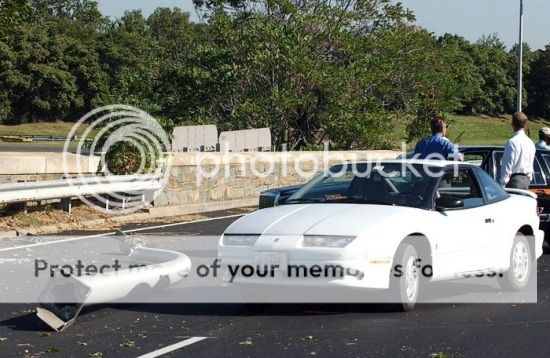
Is there room to pull that pole out of the windshield? To clear the windshield, they would need to back up another 6 feet; requiring 28 feet of room between the front of the car and the guardrail.

There are only three lanes there, the two regular lanes, and the exit lane which is slightly wider. Isn't a lane about 12 feet wide? The taxi is sitting almost crossways partially into the exit lane. Shouldn't the alleged pole have smashed into the guardrail and been forced over into Lloyd? What a fairy tale script the 9-11 perps have presented us with.

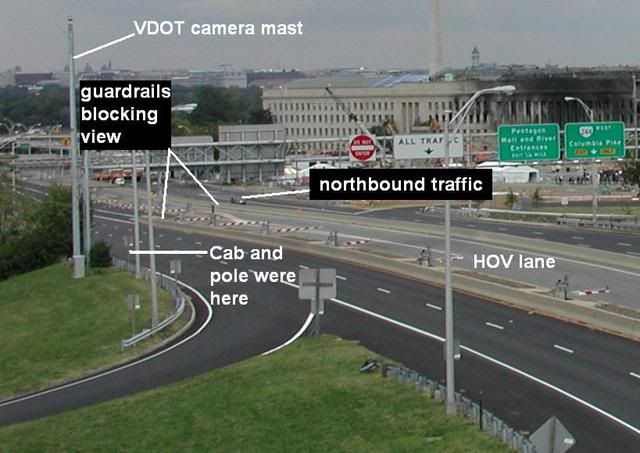
[edit on 10/31/08 by SPreston]
reply to post by SPreston
Nope, the end of the pole should be higher when it hits the windshield when it flipped.
Nope, the end of the pole should be higher when it hits the windshield when it flipped.
Did any of the pictures show cuts or scratches to Lloydes face due to flying glass from the smashed windscreen at the alleged point of impact?
Windshield glass is safety glass - glass is sandwiched with layer of plastic
to prevent flying shards.
I'd thought you would know this.....
IMO obviously its impossible that pole made that hole without killing the driver & damaging the bonnet of the car. Unless of course the pole hit the
car windshield with its tip and bounced off
In fact as thedman points out - the windshield was made of safety glass. Its designed to remain in one piece & pop out w/o much effort. Clearly, other missing damage aside, if the pole had penetrated that windshield it would have pulled the glass out with it.
Looks like someone threw a brick through that windshield, with the glass bent inwards as one would expect.
Amazing too the car wasnt kept as evidence but then the govt didnt really seemed in any evidence when it came to 9/11 except a supposed terrorists passport obviously planted at the scene..
edit: Craig Im wondering - having watched the video. Lloyd seems quite convinced he wasnt where the photos show his car was. Isnt it possible his car was moved after the event?
Good thread
[edit on 2-11-2008 by Nonchalant]
In fact as thedman points out - the windshield was made of safety glass. Its designed to remain in one piece & pop out w/o much effort. Clearly, other missing damage aside, if the pole had penetrated that windshield it would have pulled the glass out with it.
Looks like someone threw a brick through that windshield, with the glass bent inwards as one would expect.
Amazing too the car wasnt kept as evidence but then the govt didnt really seemed in any evidence when it came to 9/11 except a supposed terrorists passport obviously planted at the scene..
edit: Craig Im wondering - having watched the video. Lloyd seems quite convinced he wasnt where the photos show his car was. Isnt it possible his car was moved after the event?
Good thread
[edit on 2-11-2008 by Nonchalant]
posted by SPreston
Did any of the pictures show cuts or scratches to Lloydes face due to flying glass from the smashed windscreen at the alleged point of impact?
posted by thedman
Windshield glass is safety glass - glass is sandwiched with layer of plastic
to prevent flying shards.
I'd thought you would know this.....
IF that 200+ pound pole had struck that windshield right next to Lloyde's face at 40 mph, (the alleged speed of the taxi - but more likely 80+ mph - the alleged speed of the taxi plus the likely speed of the alleged hurled light pole allegedly struck by a 90 ton 535 mph aircraft) then that breaking glass expanding outward from the tip of the penetrating pole would have struck Lloyde's face with such great force, that it would not matter if it was sharp or not. A baseball bat has no sharp edges and one can easily cut a person's face with it. Lloyde's face and head should have been cut terribly. But no bandages and no bandaids and no treatment in sight? Correct?
A person would assume you would know this.....
Do you fanatical defenders of the government god fairy tale really think that 33 foot long 200+ pound pole flew through that teensey little hole in the windshield, and then sat meekly there not making the hole in the glass any bigger, while sticking out precariously 22 feet past the bumper, while Lloyde allegedly skidded to a stop sideways from 40 mph?

But of course since the aircraft actually flew Over the Naval Annex and North of the Citgo and since YOUR aircraft could not possibly have survived a collision with five 337 pound light poles within a time frame of one second, and since YOUR aircraft could not possibly have survived a high G pullup after hitting the five light poles at the bottom of the hill and since YOUR aircraft left NO JET FUEL on the road or on the lawn or in the Pentagon, then your argument is moot. Correct?
Uh..unhhhh. Can't do that. Not possible. Don't go there.

posted by ThroatYogurt
Just another picture Craig took of the interior of the Cab:
Hmmmm. Wonder how that broken off end of that light pole allegedly hitting that front passenger seat at over 40 mph failed to tear the leather to shreds?
Dang, I don't even think I see a tear in the leather. It looks more to me like some big husky FBI man stomped that seat into submission. And I still don't see how that teensey hole in the windshield could be so small. Must be another of the zillions of miracles and broken physics laws which have been so commonplace in the 9-11 New Pearl Harbor Event.


And this guy, hiding out behind small schoolchildren in Florida, while doing
absolutely nothing to defend America, fought desperately to prevent any
kind of investigation into 9-11.

The George Dubya Bush Commemorative Stamp
[edit on 11/2/08 by SPreston]
posted by ThroatYogurt
Some more pictures of the Cab interior.
So you believe that somehow that 33 foot long 200+ pound light pole hurled by YOUR 535 mph 757 aircraft, (by the RIGHT wing no less, which was on the OPPOSITE side of the aircraft to the taxi to the north) managed to tear a teensey hole in the center of that passenger seat, somehow bounce up and over between the seats, and then lodge into the back seat, (traveling at 40+ mph (or more likely 80+ mph) no less) all the while that 27 foot heavy end length wobbling around 22 feet out in front of the bumper did not make the hole in the windshield much much much bigger? . . . . . . . . . . .

[edit on 11/2/08 by SPreston]
reply to post by SPreston
Just a question...
The lamps and posts were specifically designed to be break away due to FAA regulation that requires any structure located within 250 feet of runway centerline has to be frangible, which means the structure needs to break away when hit by an aircraft to minimize damages to the aircraft and its pilot. I have to ask...
Are you 100% sure regarding the weight and length of the pole? There were several manufactures. Did Ranke confirm that the pole that hit the cab those dimensions?
One of the manufacturers of some of the poles around that area was "Union Metal"
www.unionmetal.com...
The specs on their poles in that area are:
The poles were breakaway style on a 18 inch transformer style base. This means that at 23 inches off the ground the pole would be broken by a Volkswagen Rabbit traveling 20 mph.
- The poles themselves were 27.66 feet high with a weight of approximately 175 pounds.
-The truss style mast arms were 8 foot long with a rise that brought the pole height up to 30 feet. The mast arm weighs between 15-20 pounds.
-The lamp head weighs approximately 70 pounds.
-The aluminum on the poles was .188 of an inch thick. The pole was 8 inches in diameter at the base and 4.5 inches in diameter at the top.
Thanks.
Just a question...
The lamps and posts were specifically designed to be break away due to FAA regulation that requires any structure located within 250 feet of runway centerline has to be frangible, which means the structure needs to break away when hit by an aircraft to minimize damages to the aircraft and its pilot. I have to ask...
Are you 100% sure regarding the weight and length of the pole? There were several manufactures. Did Ranke confirm that the pole that hit the cab those dimensions?
One of the manufacturers of some of the poles around that area was "Union Metal"
www.unionmetal.com...
The specs on their poles in that area are:
The poles were breakaway style on a 18 inch transformer style base. This means that at 23 inches off the ground the pole would be broken by a Volkswagen Rabbit traveling 20 mph.
- The poles themselves were 27.66 feet high with a weight of approximately 175 pounds.
-The truss style mast arms were 8 foot long with a rise that brought the pole height up to 30 feet. The mast arm weighs between 15-20 pounds.
-The lamp head weighs approximately 70 pounds.
-The aluminum on the poles was .188 of an inch thick. The pole was 8 inches in diameter at the base and 4.5 inches in diameter at the top.
Thanks.
VDOT owns poles #1 and #2 and provides the other poles to the Pentagon, and the other poles are identical. They have the same exact poles in their
yard which CIT visited. Look at any photo of the immediate area of the five light poles on 9-11 and the light poles are all the same.
Standard dimensions for VDOT light poles in Pentagon area

Original image
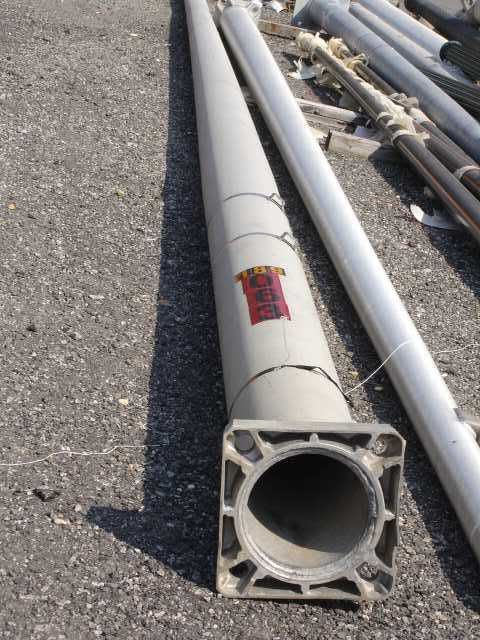
Young VDOT employee Christopher Landis mysteriously committed suicide soon after giving the Jason Ingersoll 9-11 photo collection to CIT.


Original image

[edit on 11/2/08 by SPreston]
Standard dimensions for VDOT light poles in Pentagon area

Original image

Young VDOT employee Christopher Landis mysteriously committed suicide soon after giving the Jason Ingersoll 9-11 photo collection to CIT.
We also talked with Christopher Landis who heard the plane and even had to go inside the damaged pentagon that night when he delivered the lighting. He had the entire Jason Ingersoll 9/11 photo collection with plenty of unreleased photos and he actually burned us a copy! That was a great score. So then we went outside and examined the poles. We were told they are 40 feet tall and 250lbs.


Original image

[edit on 11/2/08 by SPreston]
reply to post by SPreston
Thank you for posting the pictures again from CIT. There are more than one manufacturer of light poles outside the Pentagon. I am asking for verification that the dimensions CIT are using is accurate. Where did they obtain this information so that I can verify it.
Thank you
Thank you for posting the pictures again from CIT. There are more than one manufacturer of light poles outside the Pentagon. I am asking for verification that the dimensions CIT are using is accurate. Where did they obtain this information so that I can verify it.
Thank you
posted by ThroatYogurt
There are more than one manufacturer of light poles outside the Pentagon. I am asking for verification that the dimensions CIT are using is accurate. Where did they obtain this information so that I can verify it.
Contact the Virginia Department of Transportation and ask them yourself. Then you can obtain your information you need, and it will be unnecessary to accuse your adversaries of lying.
reply to post by SPreston
I was asking where CIT obtained their information. Did they measure the thickness themselves?
I am not accusing anyone of lying.
I was asking where CIT obtained their information. Did they measure the thickness themselves?
I am not accusing anyone of lying.
new topics
-
Thune selected as Senate Republican Leader
US Political Madness: 35 minutes ago -
Band of Brothers 2001 Classic
Television: 40 minutes ago -
US warship Edsall Lost after Pearl Harbor Attack Found 80 Years Later ... by Accident
Mainstream News: 1 hours ago -
WATCH LIVE: US Congress hearing on UFOs, unidentified anomalous phenomena
Aliens and UFOs: 3 hours ago -
Worlds Behind You…
Short Stories: 3 hours ago -
Con Man Don
Jokes, Puns, & Pranks: 3 hours ago -
How can you defend yourself when the police will not tell you what you did?
Posse Comitatus: 7 hours ago
top topics
-
Trump picks Gov. Kristi Noem to serve as homeland security secretary
2024 Elections: 16 hours ago, 14 flags -
How can you defend yourself when the police will not tell you what you did?
Posse Comitatus: 7 hours ago, 14 flags -
US warship Edsall Lost after Pearl Harbor Attack Found 80 Years Later ... by Accident
Mainstream News: 1 hours ago, 8 flags -
WATCH LIVE: US Congress hearing on UFOs, unidentified anomalous phenomena
Aliens and UFOs: 3 hours ago, 6 flags -
Worlds Behind You…
Short Stories: 3 hours ago, 4 flags -
Thune selected as Senate Republican Leader
US Political Madness: 35 minutes ago, 4 flags -
Band of Brothers 2001 Classic
Television: 40 minutes ago, 1 flags -
Con Man Don
Jokes, Puns, & Pranks: 3 hours ago, 0 flags
active topics
-
WATCH LIVE: US Congress hearing on UFOs, unidentified anomalous phenomena
Aliens and UFOs • 13 • : putnam6 -
The Trump effect 6 days after 2024 election
2024 Elections • 90 • : DBCowboy -
President-Elect DONALD TRUMP's 2nd-Term Administration Takes Shape.
Political Ideology • 143 • : burntheships -
US warship Edsall Lost after Pearl Harbor Attack Found 80 Years Later ... by Accident
Mainstream News • 7 • : KnowItAllKnowNothin -
Thune selected as Senate Republican Leader
US Political Madness • 3 • : putnam6 -
-@TH3WH17ERABB17- -Q- ---TIME TO SHOW THE WORLD--- -Part- --44--
Dissecting Disinformation • 3248 • : Thoughtful3 -
Band of Brothers 2001 Classic
Television • 1 • : PorkChop96 -
Tomorrow will be the 7th day after the election, and they are still counting
US Political Madness • 43 • : network dude -
Trump picks Gov. Kristi Noem to serve as homeland security secretary
2024 Elections • 20 • : burntheships -
Russia Ukraine Update Thread - part 3
World War Three • 6794 • : Oldcarpy2


